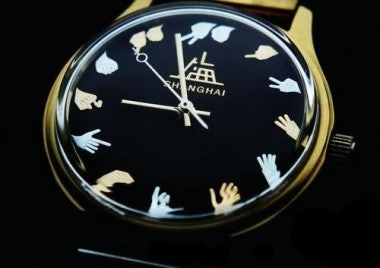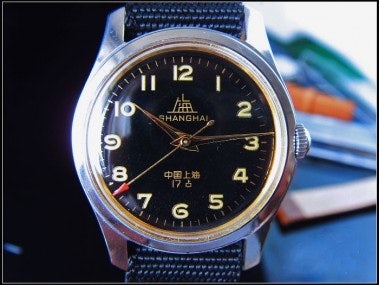Brand Has Worked On Reinvention Campaign For Two Years; Factory Has Been In Production Since 1955#

Although most of the world's top watchmakers remain cozily ensconced within the borders of Switzerland, as with most luxury industries "the Chinese are coming"...in this case, to reinvent a brand better known for gracing the wrists of Mao Zedong and Zhou En'lai than Donald Trump or Warren Buffett. (Though the latter might be more open to it than we might assume.) This brand, Shanghai Watch (上海手表厂), started producing watches in the mid-1950s, amid a flurry of activity in the Shanghai wristwatch industry, and quickly established itself as the country's top watchmaker.
While the industry took several years to operate fully independently, as producers relied heavily on imported Soviet and Japanese components throughout the 1950s, over the years companies like Shanghai Watch turned to in-house component manufacture and design, and finally were able to effectively churn out units on a wide enough scale to transform the wristwatch from a luxury to a household item. Though Shanghai Watch produced only around 14,000 units in 1958, that number soared to over 1 million by 1968 and more than doubled that only two years later. Success was staggering; In the 1960s and '70s, Shanghai watches were worn by everyone from China's laobaixing (common people) to Beijing's top brass, and a Shanghai watch became a de facto wedding gift for millions of couples. But change was right around the corner, and the mid-1970s proved to be something of a high point for Shanghai Watch.
Upon the deaths of Mao Zedong and Zhou En'lai in 1976, and following the economic reforms ushered in by Deng Xiaoping just a few years later, Shanghai Watch came to be seen by many of China's freshly minted capitalists as a relic. Indeed, 1979, the year that China's first-ever foreign television commercial (incidentally enough for Swiss-made Rado wristwatches) aired, marks the beginning of Switzerland's conquest of the Chinese high-end wristwatch market. (A market that was, at that time, admittedly, virtually a vacuum.)
Over the course of the past 30 years, Chinese watchmakers have struggled to rival foreign brands at the high end, and not one has seriously been able to compete with Rolex, Omega, Blancpain, Chopard or Vacheron Constantin. However, a couple of years ago a once-unlikely contender seemingly came out of nowhere, intent on reinventing its brand and creating a real Chinese luxury wristwatch: Shanghai Watch. Today, the Wall Street Journal looks into the reincarnation of Shanghai Watch, and the challenges the company foresees as it seeks global acceptance -- and even local acceptance in foreign-luxury-brand-mad China. From the article:
As guests sipped champagne and nibbled on Manchurian caviar at a Hong Kong watch emporium Tuesday, a female model stalked the room wearing a heavy, diamond-encrusted timepiece valued at about US$100,000.
More surprising than the price tag was the watch's manufacturer: Shanghai Watch Co., a Chinese outsider that hopes to join the ranks of wristwatch royalty dominated by European brands such as Piaget, Rolex and Audemars Piguet.
...
Two years ago, Shanghai Watch's owners began repositioning the brand at the luxury end of the market, and launched two high-end watches designed by celebrated Swiss watchmaker Eric Giroud. Unusually, while most luxury watches are powered by Swiss movements, even the guts of Shanghai Watch's timepieces are made entirely in China.
Only 200 of the rose gold and white gold watches with alligator leather straps have been created. They retail for about US$17,800 and feature a sophisticated tourbillion mechanism. The latest creation on display this week, coated with 45 carats in diamonds, was made to order for a mainland Chinese customer, and marks the most expensive watch yet designed by the 55-year-old firm.

As the article notes, Chinese watch companies will have to overcome serious psychological barriers if they're to appeal to Chinese and non-Chinese high-end buyers. However, among these Chinese brands Shanghai Watch seems to be taking the most initiative, or at least it seems to be the most open to trying new things. Last year, the Shanghai-based creative outfit Jellymon, in collaboration with Wieden + Kennedy Shanghai, worked with Shanghai Watch to create a series of five limited-edition watches, which were sold in Paris, New York and in Shanghai.
Although this run of watches, which retailed in the area of US$200, were far from Rolex levels in terms of bells and whistles, Jellymon's Shanghai Watch collaboration could give a hint at things to come when Chinese legacy brands look to rebrand and remarket themselves not only to the world, but to Chinese luxury consumers -- whose domestic-brand prejudice often runs deeper than that of non-Chinese buyers.
However, if brands like Shanghai Watch are able to convince domestic buyers not only that their quality and design is up to, and can even exceed, foreign luxury brand standards and can somehow tap into patriotic sentiment or resonate culturally, we might see more Chinese high-end brands on the upswing in coming years.